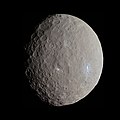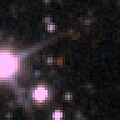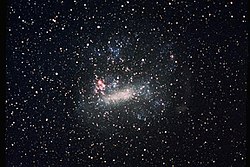An object with the spectral type T (also called T dwarf or methane brown dwarf) is either a brown dwarf or young free-floating planetary-mass object. A...
53 KB (5,535 words) - 19:56, 11 May 2025
temperature, and brown dwarfs occupy types M (2100-3500 K), L (1300-2100 K), T (600-1300 K), and Y (<600 K). As brown dwarfs do not undergo stable hydrogen...
166 KB (18,216 words) - 03:54, 1 June 2025
colder than T-dwarfs. Y-dwarfs have a similar spectrum when compared to the giant planet Jupiter. When the spectral classes of L dwarfs and T dwarfs were defined...
58 KB (5,877 words) - 11:46, 29 May 2025
Leo T is a dwarf galaxy situated in the Leo constellation and discovered in 2006 in the data obtained by Sloan Digital Sky Survey. The galaxy is located...
7 KB (826 words) - 23:40, 10 November 2024
Epsilon Indi (category T-type brown dwarfs)
two brown dwarfs, ε Indi Ba and ε Indi Bb, in a wide orbit around it. The brown dwarfs were discovered in 2003. ε Indi Ba is an early T dwarf (T1) and...
31 KB (3,017 words) - 23:40, 3 June 2025
A white dwarf is a stellar core remnant composed mostly of electron-degenerate matter. A white dwarf is very dense: in an Earth sized volume, it packs...
154 KB (17,962 words) - 15:07, 27 May 2025
Dwarfism is a condition of people and animals marked by unusually small size or short stature. In humans, it is sometimes defined as an adult height of...
43 KB (4,572 words) - 02:36, 26 May 2025
Red Dwarf is a British science fiction comedy programme created by Rob Grant and Doug Naylor, consisting of a sitcom that aired on BBC Two between 1988...
148 KB (13,737 words) - 04:53, 3 June 2025
Stellar classification (redirect from Spectral class T)
deviating mass have also been assigned letters: D for white dwarfs and L, T and Y for brown dwarfs (and exoplanets). In the MK system, a luminosity class is...
107 KB (11,634 words) - 13:02, 29 May 2025
Nine likeliest dwarf planets and dates of discovery A dwarf planet is a small planetary-mass object that is in direct orbit around the Sun, massive enough...
101 KB (9,264 words) - 16:15, 20 April 2025
planetary mass which is not gravitationally bound to any star or brown dwarf. Rogue planets may originate from planetary systems in which they are formed...
88 KB (8,716 words) - 03:02, 4 June 2025
WISE J031624.35+430709.1 (category T-type brown dwarfs)
T-class brown dwarfs known. In 2024 a T dwarf about 2 kpc distant, with a low-metallicity was discovered with the JWST. This brown dwarf is called JADES-GS-BD-9...
7 KB (591 words) - 19:33, 24 October 2024
A red dwarf is the smallest kind of star on the main sequence. Red dwarfs are by far the most common type of fusing star in the Milky Way, at least in...
36 KB (4,265 words) - 02:35, 4 June 2025
WISE 2150−7520 (category T-type brown dwarfs)
and in 2008 was found to be an ultracool dwarf with a spectral type of L. The secondary, a much cooler T dwarf, was discovered by volunteers of the citizen...
8 KB (678 words) - 16:32, 1 May 2025
2MASS J09393548−2448279 (category T-type brown dwarfs)
two nearby T-type brown dwarfs, located in constellation Antlia at 17.4 light-years from Earth. 2MASS 0939−2448 was identified as a brown dwarf through analysis...
10 KB (847 words) - 19:47, 11 May 2025
An object with the spectral type L (also called L-dwarf) can be either a low-mass star, a brown dwarf or a young free-floating planetary-mass object. If...
35 KB (3,790 words) - 18:55, 2 May 2025
(January 2011). "Transiting exoplanets from the CoRoT space mission. XV. CoRoT-15b: a brown-dwarf transiting companion". Astronomy and Astrophysics. 525:...
4 KB (174 words) - 20:16, 16 December 2024
2MASS J03480772−6022270 (category T-type brown dwarfs)
of the 2MASS Wide-Field T Dwarf Search in 2002. With a rotation period of 1.08 hours, it is the fastest-rotating brown dwarf confirmed as of 2022[update]...
25 KB (2,523 words) - 18:27, 23 February 2025
2MASS J11263991−5003550 (category L-type brown dwarfs)
a brown dwarf about 53 light-years distant from earth. The brown dwarf is notable for an unusual blue near-infrared color. This brown dwarf does not...
7 KB (722 words) - 16:43, 7 November 2024
S Ori 70 (category T-type brown dwarfs)
suggests that it is further away than expected if it were a single field T dwarf. The σ Orionis open cluster has been the focus of Osorio's team observations...
9 KB (964 words) - 15:25, 19 February 2024
A dwarf galaxy is a small galaxy composed of about 1000 up to several billion stars, as compared to the Milky Way's 200–400 billion stars. The Large Magellanic...
25 KB (2,424 words) - 06:41, 17 May 2025
SCR 1845−6357 (category T-type brown dwarfs)
a low-mass red dwarf, while the secondary is a brown dwarf. It is among the nearest stars, as well as the nearest red dwarf-brown dwarf binary. The primary...
10 KB (756 words) - 14:54, 14 May 2025
A black dwarf is a theoretical stellar remnant, specifically a white dwarf that has cooled sufficiently to no longer emit significant heat or light. Because...
11 KB (1,312 words) - 12:47, 31 May 2025
DENIS J081730.0−615520 (category T-type brown dwarfs)
DENIS J081730.0−615520 (also known as 2MASS 08173001−6155158) is a T-type brown dwarf 17 light-years (5.2 parsecs) away in the constellation Carina. It...
9 KB (806 words) - 15:30, 29 October 2024
The number of dwarf planets in the Solar System is unknown. Estimates have run as high as 200 in the Kuiper belt and over 10,000 in the region beyond...
64 KB (4,866 words) - 21:14, 22 May 2025
SDSS J141624.08+134826.7 (category T-type brown dwarfs)
wide binary system of two brown dwarfs, located in constellation Boötes. The system consists of L-type component A and T-type component B. Component A was...
25 KB (1,579 words) - 10:45, 22 October 2024
Seven Dwarfs are fictional dwarfs in the 1812 fairy tale Snow White by the Brothers Grimm and other renditions and adaptations. The Seven Dwarfs live in...
47 KB (5,542 words) - 10:41, 31 May 2025
Luhman 16 (category T-type brown dwarfs)
designated WISE 1049−5319 or WISE J104915.57−531906.1) is a binary brown-dwarf system in the southern constellation Vela at a distance of 6.51 light-years...
46 KB (4,779 words) - 09:57, 29 May 2025
SIMP J013656.5+093347 (category T-type brown dwarfs)
inclination of 80 ±12°. This brown dwarf provided the first evidence for periodic variability flux variations among T dwarfs. A team observed this object with...
13 KB (1,238 words) - 20:42, 31 May 2025
Gliese 229 (category T-type brown dwarfs)
written as Gl 229 or GJ 229) is a multiple system composed of a red dwarf and two brown dwarfs, located 18.8 light years away in the constellation Lepus. The...
27 KB (2,463 words) - 10:48, 31 May 2025



















